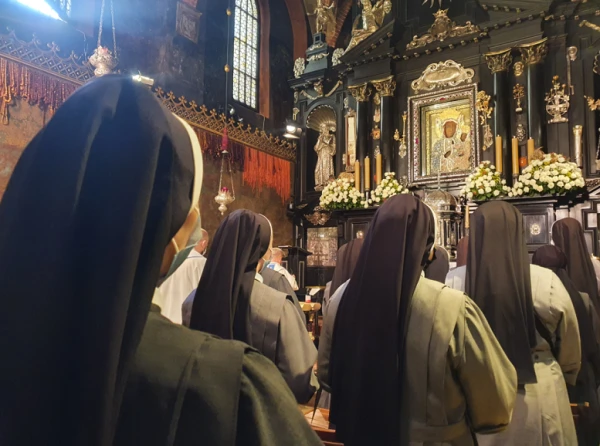Rome Newsroom, Aug 17, 2021 / 10:00 am
Nearly 40,000 Catholic pilgrims journeyed on foot, by bicycle, and on horseback to arrive at the Marian shrine of Jasna Góra in Częstochowa, Poland this summer.
The traditional walking pilgrimage to venerate an icon of the Black Madonna of Częstochowa housed in the shrine dates back to the 17th century.
Among the pilgrims to make the historic trek was Bishop Marek Solarczyk of Radom, Poland who helped to lead his diocese’s 43rd annual walking pilgrimage.
In addition to caring for the pilgrims spiritual needs, the bishop assisted with the morning wake-up call by playing his horn each morning of the roughly 100 mile journey.
Another pilgrimage group traveled to the Marian shrine on horseback. The 22nd annual cavalry pilgrimage traveled 250 miles over the course of 11 days from the village of Zaręby Kościelne in eastern Poland.
“We rode through our towns and villages, with an unfurled banner bearing the image of Our Lady of Ostra Brama, the patroness of the regiment. It was one big prayer,” Fr. Andrzej Dmochowski told the Jasna Góra Press Office.
In total, 185 cycling groups, 133 walking groups, and 13 running groups made a pilgrimage to Jasna Gora this summer.

Many of the pilgrimages culminated on the Solemnity of the Assumption of the Virgin Mary on Aug. 15.
The date holds a special significance to many Polish Catholics who commemorate it as the anniversary of the “Miracle at the Vistula.”
In the summer of 1920, Soviet forces attempted to cross Poland in order to carry out Vladimir Lenin's plan to provoke communist revolution in Western Europe. Lenin believed that if the Red Army seized Poland then the Soviets could offer direct support to revolutionaries in Germany.
With the Bolsheviks setting their sights on the Polish capital, Warsaw, Cardinal Edmund Dalbor, the Primate of Poland, joined the country's bishops at Jasna Góra, the monastery housing an icon of Our Lady of Częstochowa, also known as the Black Madonna. He led an act of consecration of the Polish nation to the Sacred Heart of Jesus.
Three weeks later, on August 15, 1920, the Polish army halted the Red Army advance on the outskirts of Warsaw. In the following days General Władysław Sikorski's 5th Army drove Soviet units away from the city.
.png?w=600)
Pilgrims at Jasna Gora this year also marked the 30th anniversary of World Youth Day in Czestochowa during which St. John Paul II entrusted all young people around the world to the Virgin Mary on Aug. 15, 1991.
John Paul II himself had a strong devotion to Our Lady of Czestochowa.
(Story continues below)
During his first visit to Jasna Gora after becoming pope, he said: “The call of a son of Poland to the cathedral of St. Peter contains an evident and strong link with this holy place, with this shrine of great hope: Totus tuus (‘I am all yours’), I had whispered in prayer so many times before this Image.”
At World Youth Day thirteen years later, the pope addressed Our Lady of Czestochowa in prayer.
“We come to you as to our Mother and, through your intercession, we ask Christ for true freedom, true faith, reasons for life and hope. You, Mother, know our limits, but also all our dreams, plans for the future, and our possibilities. Grant that we know how to make the hope that is in us fruitful,” John Paul II said.


.png?w=670&h=447)
